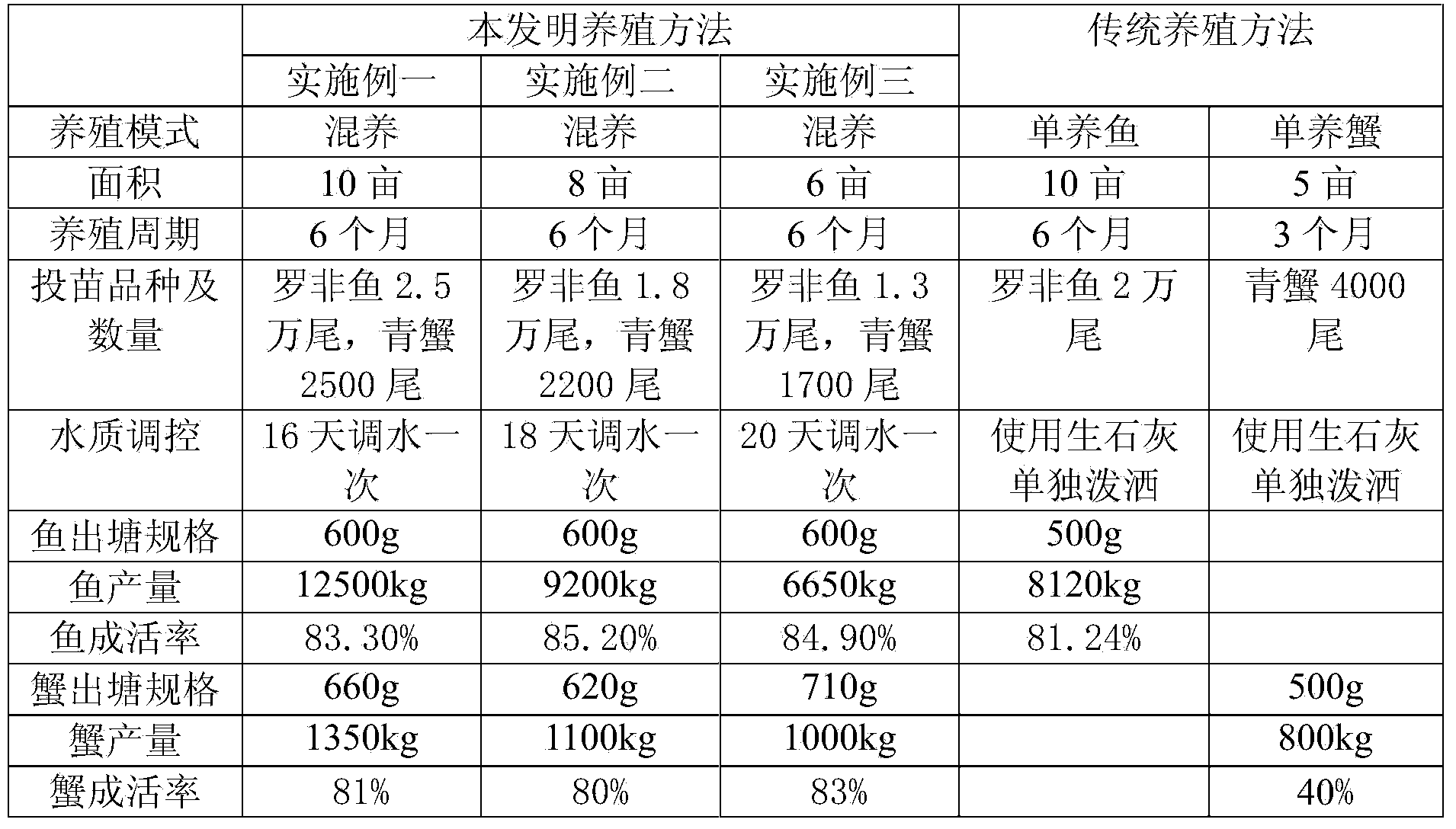Tilapia and scylla serrata polyculture method
A technology for Scylla serrata and tilapia, which is applied in the field of aquaculture, can solve problems such as restricting the development of aquaculture, low survival rate, and many diseases in monoculture of Scylla serrata, so as to improve the bottom environment, reduce the probability of disease, The effect of improving the utilization rate of bait
- Summary
- Abstract
- Description
- Claims
- Application Information
AI Technical Summary
Problems solved by technology
Method used
Image
Examples
Embodiment 1
[0018] 1. In mid-February 2012, a pond with an area of 10 mu, a pond depth of 1.8 meters, unobstructed drainage channels, power matching, complete oxygenation facilities, and convenient transportation was selected; the silt in the pond was cleaned, the pond embankment was reinforced to prevent leakage, After sunning the pond and other work, the whole pond is thoroughly disinfected; it is required to spray the bottom, wall, embankment, and all places connected to the pond with drugs.
[0019] 2. In the first ten days of March 2012, dry pond cleaning was carried out with quicklime at a dosage of 100 kg / mu. After 7 days, 25,000 fish of 3cm Gifu tilapia, 400 silver carp of 100 g / tail, and 100 g / tail were put in 300 bighead carp; 2,500 blue crab seedlings with an average shell length of 5 cm were released after mid-April.
[0020] 3. Feeding: feed with full-price compound feed for tilapia, and the daily feeding amount is calculated as 3-5% of the tilapia's body weight. Feeding is...
Embodiment 2
[0024] 1. In the first ten days of March 2012, a pond with an area of 8 mu, a pond depth of 1.5 meters, unobstructed drainage channels, power matching, complete oxygenation facilities, and convenient transportation was selected; the silt in the pond was cleaned, the pond embankment was reinforced to prevent leakage, After sunning the pond and other work, the whole pond is thoroughly disinfected; it is required to spray the bottom, wall, embankment, and all places connected to the pond with drugs.
[0025] 2. In late March 2012, dry pond cleaning was carried out with quicklime at a dosage of 130 kg / mu. Eight days later, 18,000 fish of 4cm Gifu tilapia, 240 silver carp of 100 g / tail, and 100 g / tail were put in 300 bighead carp; 2,200 blue crab seedlings with an average shell length of 6cm were released after late April.
[0026] 3. Feeding: feed with full-price compound feed for tilapia, and the daily feeding amount is calculated as 3-5% of the tilapia's body weight. Feeding i...
Embodiment 3
[0030] 1. In mid-March 2012, select a pond with an area of 6 mu, a pond depth of 1.9 meters, unobstructed drainage channels, matching power, complete oxygenation facilities, and convenient transportation; clean the silt in the pond, reinforce the pond embankment to prevent leakage, After sunning the pond and other work, the whole pond is thoroughly disinfected; it is required to spray the bottom, wall, embankment, and all places connected to the pond with drugs.
[0031] 2. In the first ten days of April 2012, dry pond cleaning was carried out with quicklime at a dosage of 150 kg / mu. After 10 days, 13,000 fish of 4cm Gifu tilapia, 170 silver carp of 100 g / tail, and 100 g / tail were put in 200 bighead carp; 1,700 blue crab seedlings with an average shell length of 5 cm were released after the first ten days of May.
[0032] 3. Feeding: feed with full-price compound feed for tilapia, and the daily feeding amount is calculated as 3-5% of the tilapia's body weight. Feeding is div...
PUM
 Login to View More
Login to View More Abstract
Description
Claims
Application Information
 Login to View More
Login to View More - R&D
- Intellectual Property
- Life Sciences
- Materials
- Tech Scout
- Unparalleled Data Quality
- Higher Quality Content
- 60% Fewer Hallucinations
Browse by: Latest US Patents, China's latest patents, Technical Efficacy Thesaurus, Application Domain, Technology Topic, Popular Technical Reports.
© 2025 PatSnap. All rights reserved.Legal|Privacy policy|Modern Slavery Act Transparency Statement|Sitemap|About US| Contact US: help@patsnap.com

